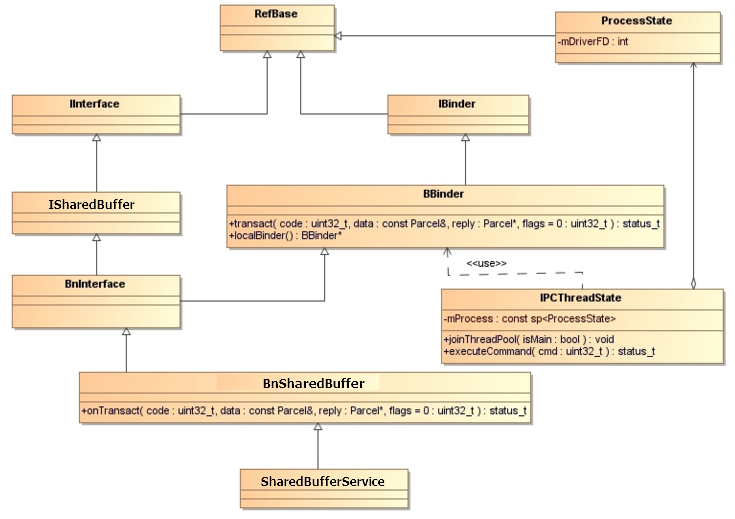Server获得了Service Manager远程接口之后,就要把自己的Service添加到Service Manager中去,然后把自己启动起来,等待Client的请求。本文将通过分析说明Server的启动过程是怎么样的。我们通过Android Binder实列篇中的实列来说明下服务启动的整个过程。
类的继承关系图:

从上图可以明显看出BnShareBuffer实际是继承了IShareBuffer和BBinder类。IShareBuffer和BBinder类又分别继承了IInterface和IBinder类,IInterface和IBinder类又同时继承了RefBase类。
实际上,BnShareBuffer并不是直接接收到Client处发送过来的请求,而是使用了IPCThreadState接收Client处发送过来的请求,而IPCThreadState又借助了ProcessState类来与Binder驱动程序交互。IPCThreadState接收到了Client处的请求后,就会调用BBinder类的transact函数,并传入相关参数,BBinder类的transact函数最终调用BnShareBuffer类的onTransact函数,于是,就开始真正地处理Client的请求了。
源码中通过:
SharedBufferService::instantiate();//add to the systemServer
static void instantiate()
{
defaultServiceManager()->addService(String16(SHARED_BUFFER), new SharedBufferService());
}前面分析过defaultServiceManager()是如何获取systemServices远程代理的。本文主要分析addService这个过程是如何一步一步在系统中添加服务的。
BpServiceManger::addService的实现在framworks/native/libs/binder/IServiceManager.cpp中。
class BpServiceManager : public BpInterface<IServiceManager>
{
public:
BpServiceManager(const sp<IBinder>& impl)
: BpInterface<IServiceManager>(impl)
{
}
....
virtual status_t addService(const String16& name, const sp<IBinder>& service,
bool allowIsolated)
{
Parcel data, reply;
unsigned n;
status_t err;
/*
*写入数据到parcel中,序列化数据
*/
data.writeInterfaceToken(IServiceManager::getInterfaceDescriptor());
data.writeString16(name);
//写入一个binder引用
data.writeStrongBinder(service);
data.writeInt32(allowIsolated ? 1 : 0);
for (n = 1; n <= 5; n++) {
err = remote()->transact(ADD_SERVICE_TRANSACTION, data, &reply);
if (err == -EPIPE) {
ALOGI("%s is waiting for serviceManager... (retry %d)\n",
String8(name).string(), n);
sleep(1);
} else {
break;
}
}
return err == NO_ERROR ? reply.readExceptionCode() : err;
}
....
};下面我们看看data.writeStrongBinder(service); 这个是服务注册的关键之所在!
status_t Parcel::writeStrongBinder(const sp<IBinder>& val)
{
return flatten_binder(ProcessState::self(), val, this);
}status_t flatten_binder(const sp<ProcessState>& proc,
const sp<IBinder>& binder, Parcel* out)
{
flat_binder_object obj; //内核中传输binder的结构
/*
*0x7f表示处理本Binder实体请求数据包的线程的最低优先级,FLAT_BINDER_FLAG_ACCEPTS_FDS
*表示这个Binder实体可以接受文件描述符,Binder实体在收到文件描述符时,就会在本进程中打开这个文件。
*/
obj.flags = 0x7f | FLAT_BINDER_FLAG_ACCEPTS_FDS;
if (binder != NULL) { //binder为 新建立的SharedBufferService一定不为空
IBinder *local = binder->localBinder();
if (!local) {
BpBinder *proxy = binder->remoteBinder();
if (proxy == NULL) {
LOGE("null proxy");
}
const int32_t handle = proxy ? proxy->handle() : 0;
obj.type = BINDER_TYPE_HANDLE;
obj.handle = handle;
obj.cookie = NULL;
} else {
obj.type = BINDER_TYPE_BINDER;
obj.binder = local->getWeakRefs();
obj.cookie = local;
}
} else {
obj.type = BINDER_TYPE_BINDER;
obj.binder = NULL;
obj.cookie = NULL;
}
return finish_flatten_binder(binder, obj, out); //将binder写入Parcel中
} inline static status_t finish_flatten_binder(
const sp<IBinder>& binder, const flat_binder_object& flat, Parcel* out)
{
return out->writeObject(flat, false); //最终调用writeObject写入一个对像
} 接下来status_t err = remote()->transact(ADD_SERVICE_TRANSACTION, data, &reply);
这里的remote成员函数来自于BpRefBase类,它返回一个BpBinder指针。
status_t BpBinder::transact(
uint32_t code, const Parcel& data, Parcel* reply, uint32_t flags)
{
// Once a binder has died, it will never come back to life.
if (mAlive) {
status_t status = IPCThreadState::self()->transact(
mHandle, code, data, reply, flags);
if (status == DEAD_OBJECT) mAlive = 0;
return status;
}
return DEAD_OBJECT;
} 最终调用IPCThreadState::transact进执行实际的操作。这里的mHandle一定为0,因为这里表示的是Service Manager远程接口,它的句柄值一定是0,code为ADD_SERVICE_TRANSACTION。
status_t IPCThreadState::transact(int32_t handle,
uint32_t code, const Parcel& data,
Parcel* reply, uint32_t flags)
{
status_t err = data.errorCheck();
flags |= TF_ACCEPT_FDS;
IF_LOG_TRANSACTIONS() {
TextOutput::Bundle _b(alog);
alog << "BC_TRANSACTION thr " << (void*)pthread_self() << " / hand "
<< handle << " / code " << TypeCode(code) << ": "
<< indent << data << dedent << endl;
}
if (err == NO_ERROR) {
LOG_ONEWAY(">>>> SEND from pid %d uid %d %s", getpid(), getuid(),
(flags & TF_ONE_WAY) == 0 ? "READ REPLY" : "ONE WAY");
err = writeTransactionData(BC_TRANSACTION, flags, handle, code, data, NULL);
}
if (err != NO_ERROR) {
if (reply) reply->setError(err);
return (mLastError = err);
}
if ((flags & TF_ONE_WAY) == 0) {
#if 0
if (code == 4) { // relayout
LOGI(">>>>>> CALLING transaction 4");
} else {
LOGI(">>>>>> CALLING transaction %d", code);
}
#endif
if (reply) {
err = waitForResponse(reply);
} else {
Parcel fakeReply;
err = waitForResponse(&fakeReply);
}
#if 0
if (code == 4) { // relayout
LOGI("<<<<<< RETURNING transaction 4");
} else {
LOGI("<<<<<< RETURNING transaction %d", code);
}
#endif
IF_LOG_TRANSACTIONS() {
TextOutput::Bundle _b(alog);
alog << "BR_REPLY thr " << (void*)pthread_self() << " / hand "
<< handle << ": ";
if (reply) alog << indent << *reply << dedent << endl;
else alog << "(none requested)" << endl;
}
} else {
err = waitForResponse(NULL, NULL);
}
return err;
} 最终通过waitForResponse ==>talkWithDriver将注册信息写入驱动。最终会唤醒在等待数据的serviceManager线程,serviceManager线程接收到数据后,会对其进行解析并添加服务到管理的服务列表中!整个过程比较复杂,在老罗的博客中有较详细的讲述!
Android系统进程间通信(IPC)机制Binder中的Server启动过程源代码分析






















 3088
3088

 被折叠的 条评论
为什么被折叠?
被折叠的 条评论
为什么被折叠?








